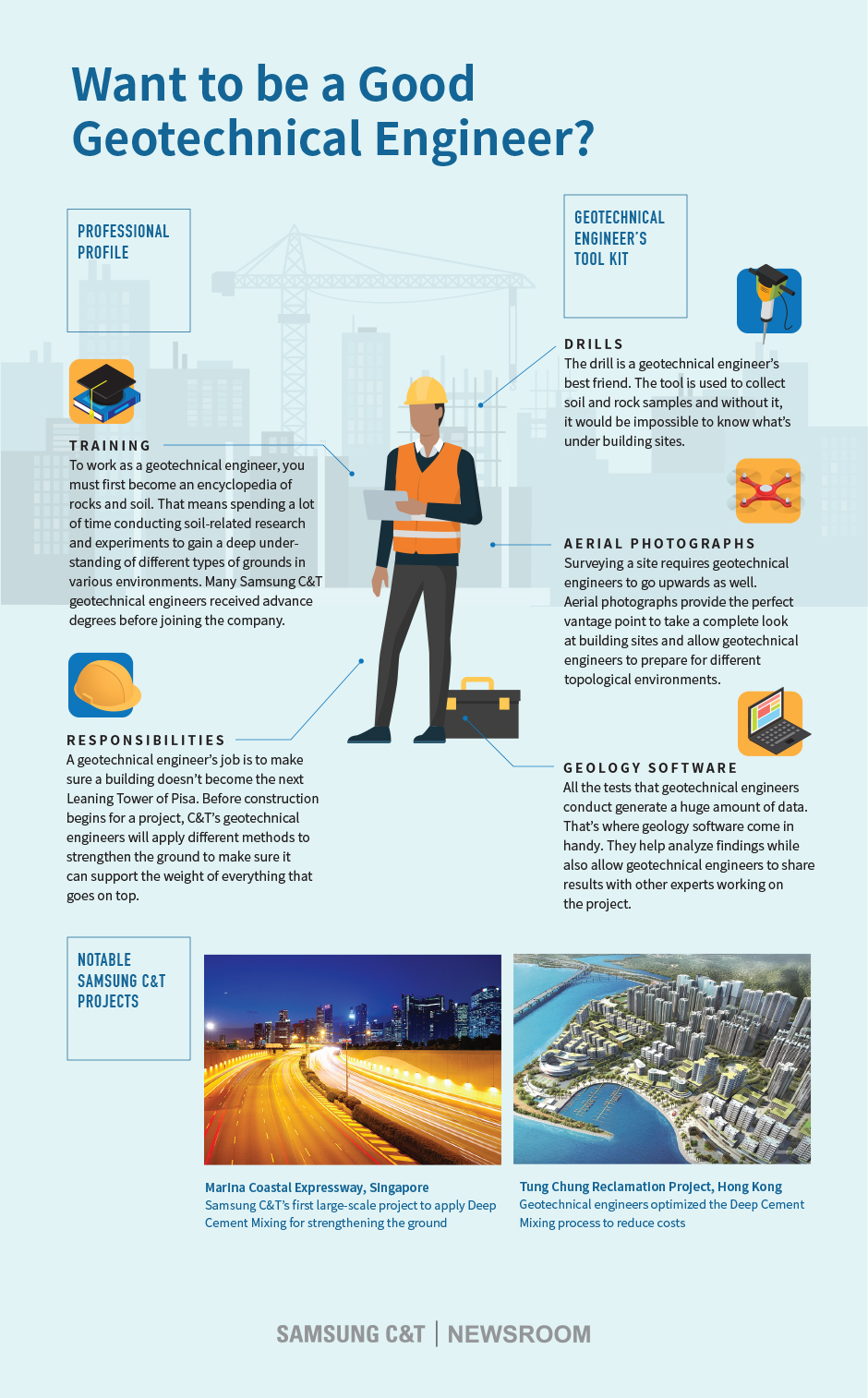Geotheta Fundamentals Explained
Geotheta Fundamentals Explained
Blog Article
Geotheta - Truths
Table of ContentsGeotheta Fundamentals ExplainedThe 6-Second Trick For GeothetaGetting My Geotheta To WorkGetting The Geotheta To WorkGeotheta for Beginners

They conduct site investigations, accumulate examples, execute laboratory tests, and evaluate information to evaluate the suitability of the ground for building and construction projects - Engineer of Record. Based on their findings, geotechnical engineers give suggestions for structure design, incline stability, keeping structures, and mitigation of geotechnical hazards. They team up with other professionals, such as designers, structural designers, and construction teams, to guarantee that geotechnical factors to consider are integrated into the general task layout and implementation
By evaluating the habits and residential or commercial properties of soil and rock, they can determine potential geotechnical hazards such as landslides, soil negotiation, or slope instability. Their proficiency aids protect against failings or mishaps that might threaten lives and home. Here are some comprehensive tasks and obligations of a geotechnical engineer: Site Examination: Geotechnical designers conduct site examinations to gather data on subsurface conditions.
They translate the data to recognize the residential or commercial properties and habits of the dirt and rock, including their stamina, leaks in the structure, compaction characteristics, and groundwater conditions. Geotechnical Analysis and Style: Geotechnical engineers evaluate the data collected throughout site examinations to assess the stability and viability of the website for building and construction projects. They do geotechnical computations and modeling to review factors such as bearing ability, settlement, incline security, side planet pressures, and groundwater circulation.
Geotheta Fundamentals Explained
Structure Design: Geotechnical designers play a vital duty in making structures that can securely support the desired structure. They assess the dirt problems and lots demands to figure out the ideal foundation type, such as shallow foundations (e.g., footings), deep foundations (e.g (https://www.edocr.com/v/p4pabymp/ianhammond2191/geotheta)., heaps), or specialized methods like dirt improvement. They think about elements such as negotiation limits, bearing ability, and soil-structure communication to create optimum structure layouts
They assess building and construction strategies, screen site tasks, and perform field assessments to confirm that the design recommendations are complied with. If unexpected geotechnical problems develop, they examine the situation and give referrals for remediation or changes to the style. Danger Evaluation and Mitigation: Geotechnical engineers analyze geotechnical hazards and dangers related to the project site, such as landslides, liquefaction, or dirt erosion.

Partnership and Communication: Geotechnical designers work closely with other professionals associated with a job, such as designers, structural engineers, and building and construction groups. Efficient communication and collaboration are vital to integrate geotechnical considerations into the overall job design and construction procedure. Geotechnical designers offer technological expertise, response questions, and ensure that geotechnical requirements are fulfilled.
A Biased View of Geotheta
Right here are some kinds of geotechnical engineers: Structure Engineer: Structure engineers concentrate on developing and evaluating foundations for structures. They examine the dirt conditions, load requirements, and site features to determine the most proper foundation type and style, such as shallow foundations, deep foundations, or specialized techniques like heap structures.
They assess the aspects affecting incline stability, such as soil residential properties, groundwater conditions, and slope geometry, and establish approaches to avoid slope failures and alleviate dangers. Quake Designer: Earthquake engineers concentrate on analyzing and designing structures to stand up to seismic pressures. They evaluate the seismic hazard of a site, assess dirt liquefaction possibility, and create seismic design criteria to make certain the safety and security and strength of frameworks during earthquakes.
They carry out field testing, collect examples, and assess the accumulated data to define the soil residential or commercial properties, geologic formations, and groundwater conditions at a website. Geotechnical Instrumentation Engineer: Geotechnical instrumentation engineers concentrate on monitoring and determining the behavior of dirt, rock, and frameworks. They set up and preserve instrumentation systems that monitor elements such as soil negotiation, groundwater levels, incline motions, and structural find here variations to examine performance and offer very early cautions of possible problems.
The smart Trick of Geotheta That Nobody is Discussing
They perform examinations such as triaxial examinations, debt consolidation tests, straight shear tests, and leaks in the structure examinations to gather information for geotechnical analysis and design. Geosynthetics Engineer: Geosynthetics designers focus on the design and application of geosynthetic products, such as geotextiles, geogrids, and geomembranes. They utilize these products to improve dirt stability, enhance slopes, give drainage remedies, and control disintegration.
They have a tendency to be investigatory people, which implies they're intellectual, reflective, and investigative. They are interested, methodical, sensible, logical, and logical. A few of them are additionally social, indicating they're kind, charitable, cooperative, patient, caring, handy, compassionate, skillful, and pleasant. Does this seem like you? Take our free occupation examination to figure out if geotechnical designer is one of your top profession matches.
In the workplace environment, geotechnical engineers utilize specialized software application devices to execute calculations, create designs, and analyze data. They prepare reports, evaluation job specs, connect with customers and group members, and coordinate job activities. The office setup supplies a conducive environment for study, analysis, and collaboration with various other professionals included in the job.
The Facts About Geotheta Revealed
They frequently see job sites to perform site investigations, assess geotechnical problems, and gather information for analysis. These visits entail traveling to various areas, sometimes in remote or difficult surfaces. Geotechnical engineers might perform soil tasting, conduct examinations, and display building and construction activities to make certain that the geotechnical aspects of the job are being applied correctly.
Geotechnical designers additionally operate in specialized geotechnical laboratories. In these centers, they conduct experiments, carry out examinations on dirt and rock samples, and assess the engineering buildings of the materials. Geotechnical lab engineers function thoroughly in these settings, handling testing equipment, running tools, and recording data. They work together with various other laboratory personnel to make certain accurate and reliable testing results.
Report this page